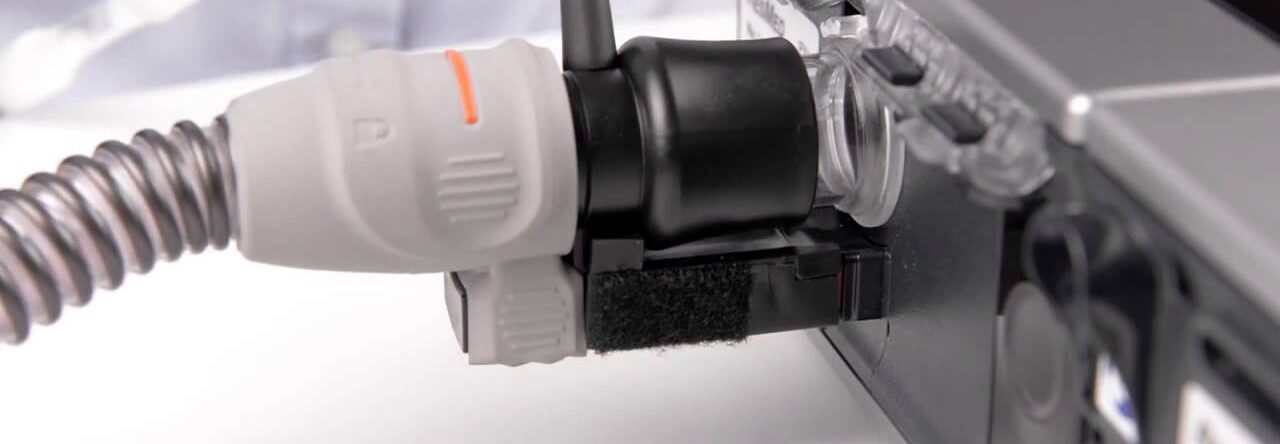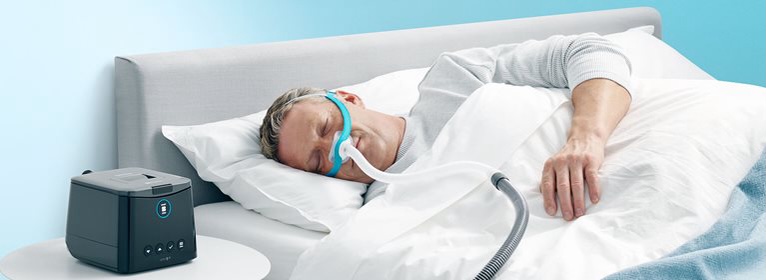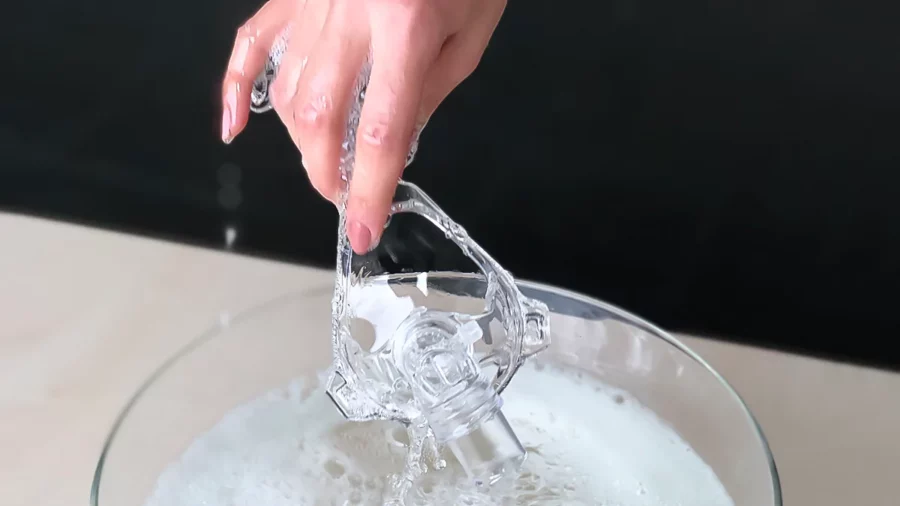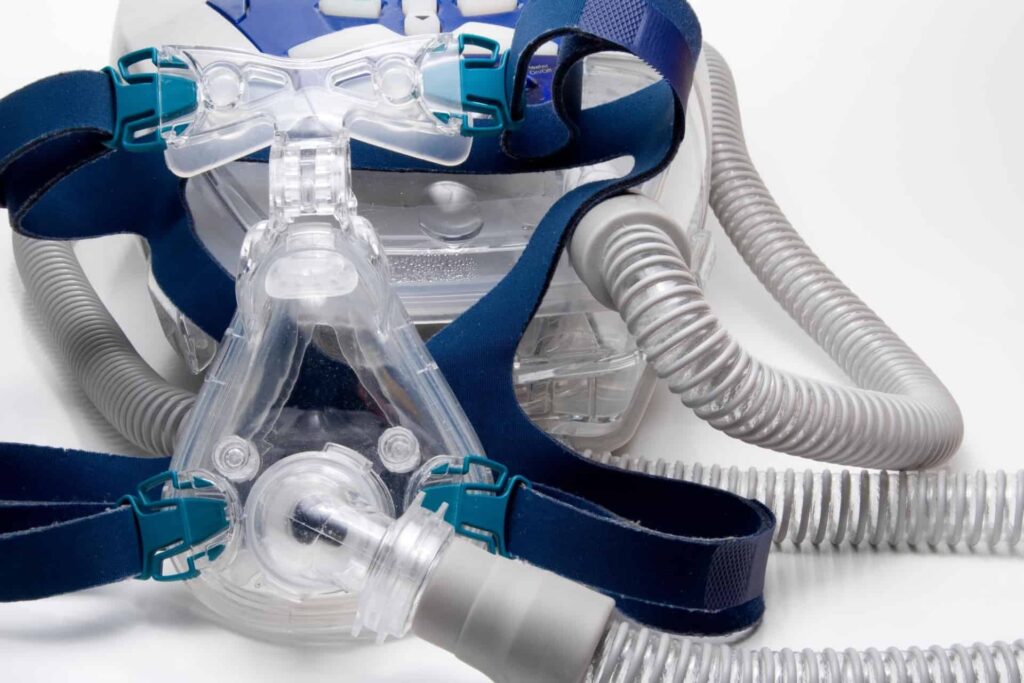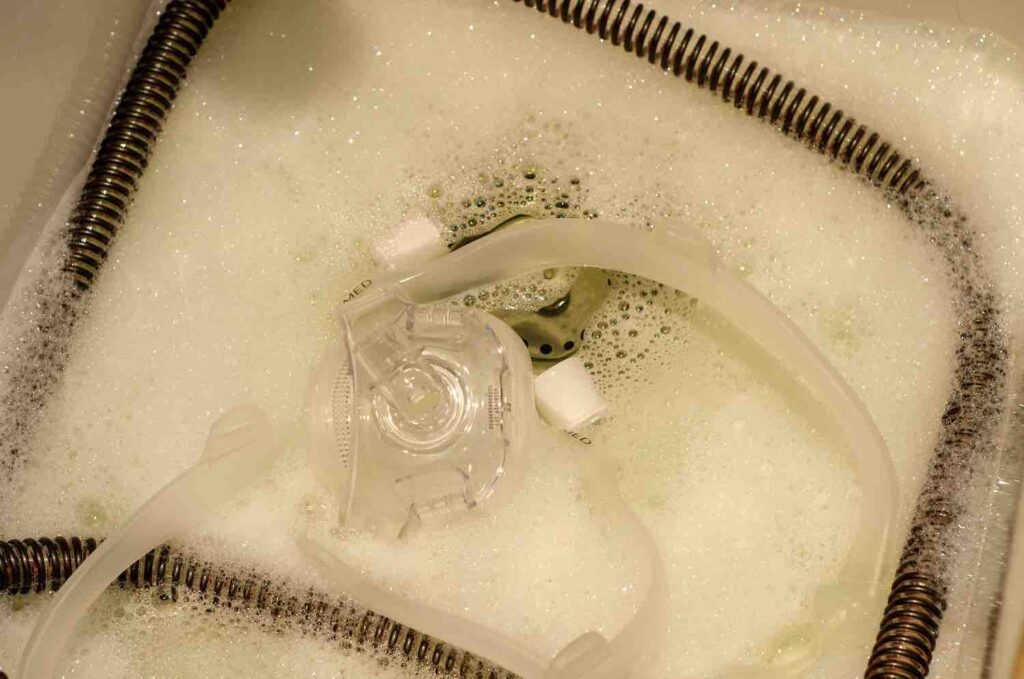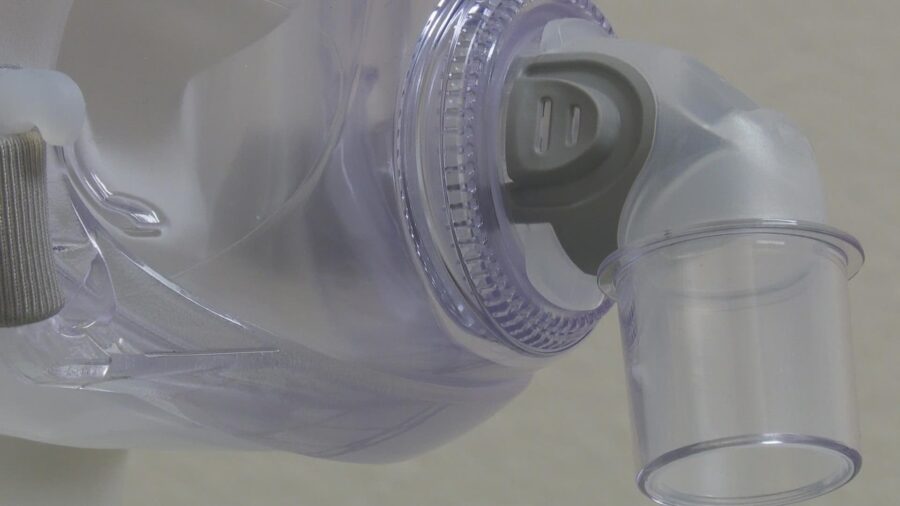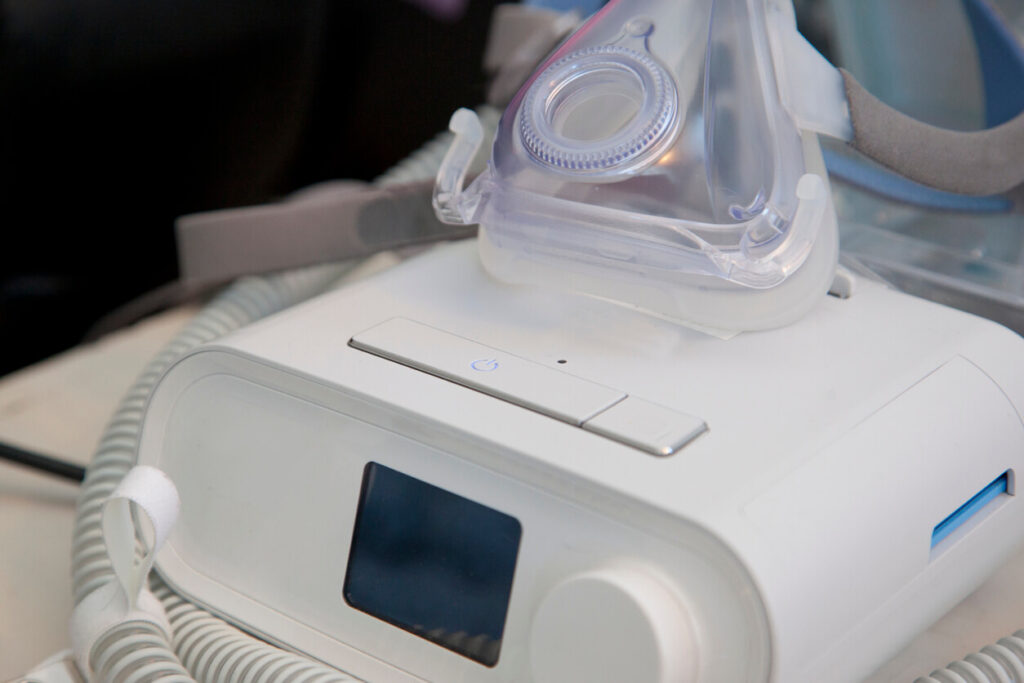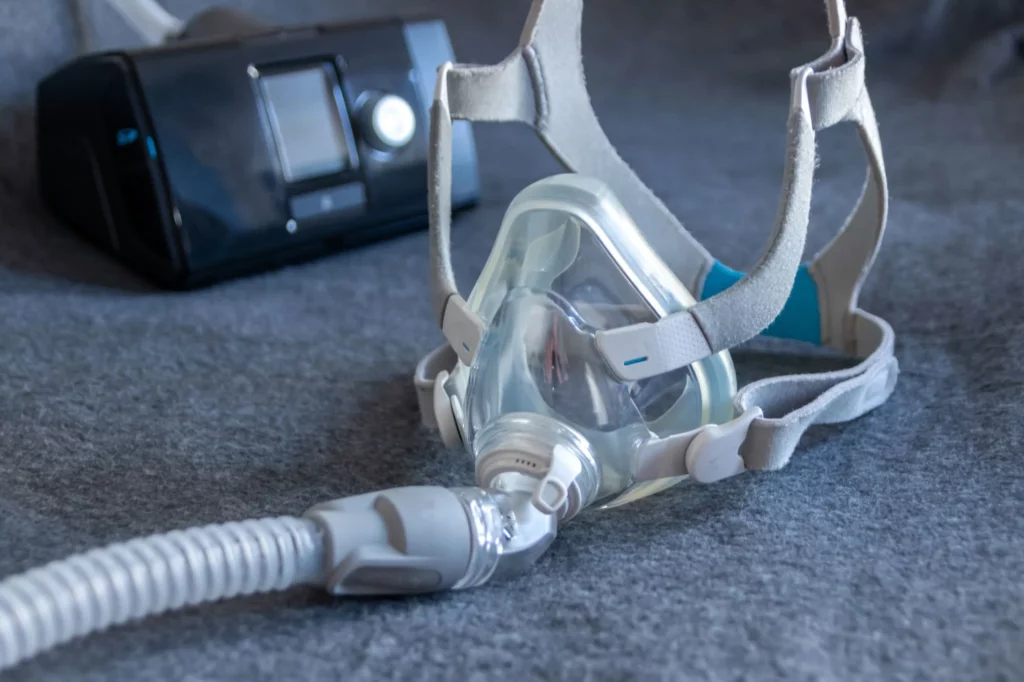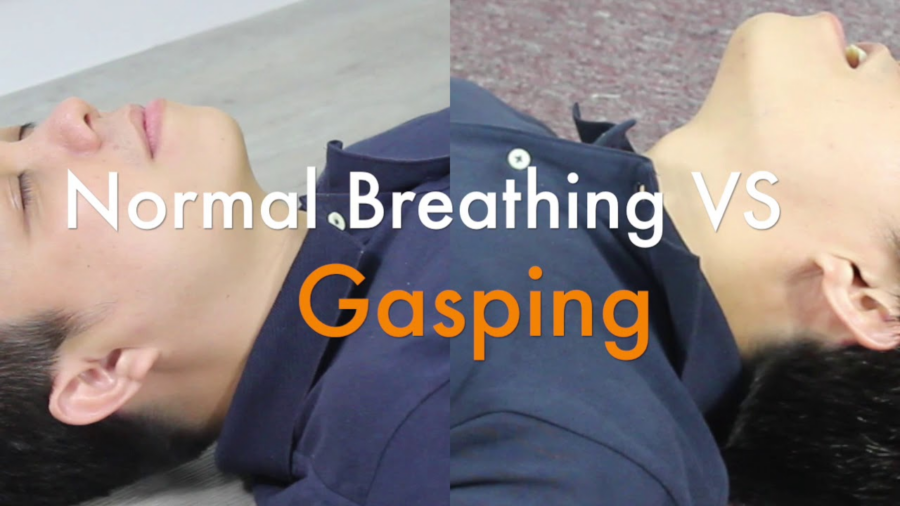What Is a CPAP Machine and How Does It Work?
A CPAP machine delivers continuous positive airway pressure through a mask to prevent airway collapse during sleep, making it the gold standard for OSA treatment. The device pushes a steady stream of pressurized air into your throat, keeping the soft tissues from blocking your breathing passages throughout the night.
The mechanics of CPAP Machines are straightforward: a motor draws in room air, pressurizes it to your prescribed level, and sends it through a tube to your mask. This constant air pressure acts as a pneumatic splint, holding your airway open so oxygen flows freely to your lungs while you sleep.

CPAP therapy differs from other positive airway pressure devices in important ways:
- CPAP machines maintain one fixed pressure setting all night long
- APAP (Auto-adjusting PAP) devices sense your breathing and automatically adjust pressure levels moment-to-moment
- BiPAP (Bilevel PAP) machines deliver higher pressure when you inhale and lower pressure when you exhale
- ASV (Adaptive Servo-Ventilation) devices dynamically respond to complex breathing patterns, typically prescribed for central sleep apnea
Understanding these distinctions helps you work with your doctor to identify which device best matches your specific breathing patterns and sleep apnea severity. Each type addresses different therapeutic needs, making proper selection critical for successful treatment outcomes.
Why Is a Doctor’s Prescription Essential for Choosing a CPAP Machine?
A CPAP prescription is legally required to purchase a CPAP machine because obstructive sleep apnea is a medical condition that demands professional diagnosis and treatment planning. Without a prescription, you cannot obtain a CPAP device from legitimate medical suppliers or have insurance coverage approved.
The sleep study, conducted either in a lab or at home, provides critical data that determines your specific therapy needs. This diagnostic test measures how often your breathing stops, your oxygen levels, and the severity of your sleep apnea. Your doctor analyzes these results to prescribe the exact pressure settings your airways need to remain open throughout the night.
Pressure settings vary significantly between individuals—typically ranging from 4 to 20 cm H2O. Using incorrect pressure can lead to:
- Ineffective treatment that fails to prevent breathing interruptions
- Discomfort causing poor compliance and therapy abandonment
- Potential side effects like aerophagia (air swallowing) or mask leaks
- Worsening of symptoms if pressure is too low
Your prescription specifies not only the pressure level but may also indicate whether you need a standard CPAP, APAP, or BiPAP machine based on your breathing patterns. This medical guidance ensures your therapy addresses your specific condition safely and effectively, maximizing the health benefits while minimizing risks associated with improper treatment.
What Types of PAP Devices Are Available and Which One Suits Different Needs?
There are several types of Positive Airway Pressure (PAP) devices available, each designed to cater to specific needs and preferences. Here’s a breakdown of the different types of PAP machines and who they are best suited for:
1. CPAP Machines
Continuous Positive Airway Pressure (CPAP) machines deliver a single, fixed pressure throughout the night. They are the most common and straightforward option for treating obstructive sleep apnea.
- Who it’s for: CPAP machines work well for patients with consistent breathing patterns and stable pressure requirements.
2. APAP Machines
Automatic Positive Airway Pressure (APAP) machines automatically adjust pressure levels in real-time based on your breathing patterns. These devices increase pressure when they detect airway resistance and decrease it during periods of normal breathing.
- Who it’s for: APAP machines offer flexibility for patients whose pressure needs vary throughout the night or across different sleep positions.
3. BiPAP Machines
Bilevel Positive Airway Pressure (BiPAP) machines provide two distinct pressure levels: a higher pressure during inhalation and a lower pressure during exhalation.
- Who it’s for: This dual-pressure system benefits patients who struggle with exhaling against continuous pressure, those requiring higher pressure settings, or individuals with certain respiratory conditions beyond sleep apnea.
4. ASV Machines
Adaptive Servo-Ventilation (ASV) machines represent the most advanced technology, continuously monitoring breathing patterns and adjusting pressure breath-by-breath.
- Who it’s for: These devices primarily treat central sleep apnea or complex sleep apnea syndrome, where the brain fails to send proper breathing signals.
Your specific needs determine the right device type. Patients with straightforward obstructive sleep apnea typically start with standard CPAP machines. Those experiencing pressure intolerance, variable breathing patterns, or difficulty exhaling may benefit from APAP or BiPAP options. Your sleep study results and physician’s assessment guide this critical decision.
What Features Should Be Considered When Choosing a CPAP Machine?
The right CPAP features directly impact therapy success and nightly comfort. Modern machines offer various specifications that address different user needs, from noise levels to travel convenience.
Quiet Operation
Noise levels matter significantly when selecting equipment for nightly use. Today’s CPAP machines typically operate between 25-30 decibels—comparable to a whisper or soft library environment. Quieter models prevent sleep disruption for both users and bed partners, creating a peaceful bedroom atmosphere. Machines with sound ratings below 26 decibels offer the most discreet operation, particularly valuable for light sleepers or those sharing a bedroom.
Portability and Travel-Friendly Design
Compact, lightweight machines serve active individuals and frequent travelers best. Standard CPAP devices weigh 2-5 pounds, while travel-specific models reduce this to under 1 pound. Battery compatibility extends therapy beyond traditional outlets—essential for camping trips, international travel, or areas with unreliable power. Machines with universal voltage (100-240V) eliminate the need for converters abroad.
Ease of Use and Interface
Intuitive controls simplify daily operation. Look for machines with clear displays showing pressure settings, usage hours, and mask leak data. Ease of Use and Interface is enhanced by smartphone connectivity, which enables remote monitoring and adjustment tracking. One-button operation benefits users who prefer straightforward functionality without complex menus, while automatic altitude adjustment ensures consistent therapy regardless of elevation changes during travel.
How Does Mask Selection Impact Comfort and Effectiveness?
CPAP mask types directly determine whether you’ll stick with therapy or abandon it due to discomfort. The right mask creates an effective seal while feeling natural enough to wear throughout the night.
Three primary CPAP mask types serve different breathing patterns and facial structures:
- Nasal masks cover only the nose, offering a balanced option for those who breathe primarily through their nose during sleep
- Nasal pillow masks insert small cushions directly into the nostrils, providing minimal facial contact and working well for claustrophobic users or those who wear glasses before bed
- Full-face masks cover both nose and mouth, delivering air through either passage
Full-face masks become essential for mouth breathers or anyone experiencing chronic nasal congestion. If you wake with a dry mouth or your partner notices you sleeping with your mouth open, this style prevents air leaks that compromise therapy effectiveness. Those with seasonal allergies, deviated septums, or sinus conditions also benefit from the dual-pathway design.
Mask fit matters as much as style. An improperly sized mask creates pressure points, red marks, or air leaks that trigger the machine to increase pressure unnecessarily. Most suppliers offer fitting sessions to test different sizes and styles before committing to a purchase. The cushion material—typically silicone or gel—affects both comfort and seal quality against your skin.
What Accessories Can Enhance the CPAP Therapy Experience?
Heated humidifiers transform CPAP therapy by adding moisture to the pressurized air, preventing the dry mouth, throat irritation, and nasal congestion that many users experience. Most modern CPAP machines either include built-in humidifiers or offer them as compatible add-ons, with adjustable settings to match individual comfort preferences and environmental conditions.
A heated hose works in tandem with the humidifier to maintain consistent air temperature from the machine to your mask. Without heating, moisture in the tube can cool and condense, creating “rainout”—water droplets that collect in the tubing and disrupt therapy. Heated hoses eliminate this problem by keeping the air warm throughout its journey, ensuring you receive comfortable, properly humidified air all night.
Mask liners provide an additional layer of comfort between your skin and the mask cushion. These soft fabric barriers:
- Reduce skin irritation and pressure marks from prolonged mask contact
- Improve the seal by absorbing facial oils and moisture
- Extend mask cushion lifespan by protecting it from direct skin contact
- Create a more comfortable sleeping experience for users with sensitive skin
The combination of these accessories addresses the most common comfort complaints associated with CPAP therapy. Users who add humidification and heated hoses report significantly better sleep quality and higher compliance rates, making these accessories valuable investments rather than optional extras.
How Important Is Regular Maintenance and Replacement for Effective Therapy?

CPAP maintenance directly impacts therapy effectiveness and your health. Without proper cleaning and timely replacement of components, bacteria and mold can accumulate, leading to respiratory infections and reduced machine performance.
Daily and Weekly Cleaning Tasks
- Daily cleaning of your mask cushion
- Weekly washing of the entire mask assembly with mild soap and water
- Weekly cleaning of the headgear
- Weekly inspection and cleaning of hoses
These cleaning tasks are essential to prevent skin irritation, bacterial growth, moisture buildup, and potential contaminants.
Filter Change Guidelines
Filter change schedules vary by machine type but typically follow these guidelines:
- Disposable white filters: Replace every 2-4 weeks
- Reusable gray foam filters: Clean weekly, replace every 3 months
- Water chamber: Empty and rinse daily, deep clean weekly
Mask and Headgear Replacement
Mask replacement should occur every 3-6 months as cushions lose their shape and seal quality deteriorates. Headgear stretches over time, requiring replacement every 6 months to maintain proper fit.
Tubing Replacement
Tubing develops micro-tears and should be replaced every 3 months.
Neglecting these maintenance schedules reduces air pressure delivery, compromises treatment efficacy, and voids manufacturer warranties. Most insurance plans cover regular supply replacements when following recommended schedules, making adherence to CPAP maintenance protocols both medically necessary and financially practical. How to Choose the Right CPAP Machine for Your Sleep Apnea Treatment includes understanding these ongoing care requirements before purchase.
Will Insurance Cover the Cost of a CPAP Machine?
Most health insurance plans provide insurance coverage for CPAP machines, but approval hinges on meeting specific medical criteria. Insurers require documented proof of obstructive sleep apnea through an official sleep study report conducted at an accredited facility or via home sleep testing.
Medicare CPAP Coverage
Medicare CPAP coverage follows a structured approval process. Beneficiaries must complete a face-to-face evaluation with their physician and undergo a qualifying sleep study showing an apnea-hypopnea index (AHI) of 15 or higher, or an AHI between 5-14 with documented symptoms like excessive daytime sleepiness. Medicare typically covers 80% of the approved amount after the Part B deductible is met.
Private Insurance Requirements
Private insurance carriers maintain similar requirements but vary in their specific policies:
- Pre-authorization may be mandatory before purchasing equipment
- Compliance monitoring during a trial period (usually 30-90 days) to verify regular usage
- Rental-to-own programs where insurers rent the machine initially before transferring ownership
- Coverage for supplies including masks, filters, tubing, and humidifier chambers on a scheduled replacement basis
Documentation from your sleep physician proving medical necessity strengthens insurance claims. For example, Aetna’s medical policy outlines specific requirements that need to be met for CPAP coverage. Always contact your insurance provider directly to understand your plan’s specific coverage limits, copayments, and approved supplier networks before purchasing a CPAP machine.
Are There Specialized Machines for Travel or On-the-Go Use?
Yes, travel CPAP machines are specifically engineered for portability without compromising therapy effectiveness. These devices typically weigh between 0.6 to 2 pounds—significantly lighter than standard home units that can weigh 5 pounds or more.
Travel CPAP machines distinguish themselves through several key design features:
- Compact dimensions that fit easily into carry-on luggage or backpacks
- Universal power compatibility including AC adapters, DC car chargers, and battery packs
- FAA approval for use during flights on most commercial airlines
- Simplified controls with fewer buttons and intuitive interfaces
- Integrated humidification or compatibility with portable humidifier attachments
The advantages for frequent travelers extend beyond size reduction. Business professionals who travel weekly maintain consistent therapy across time zones and hotel rooms. Outdoor enthusiasts can bring their devices on camping trips using battery power sources. International travelers benefit from auto-adjusting voltage capabilities that work with different electrical systems worldwide.
Most travel CPAP machines deliver the same therapeutic pressure ranges as full-size units, ensuring treatment quality remains unchanged. The primary trade-off involves reduced water chamber capacity in humidifiers and potentially shorter tubing lengths. Patients who split time between multiple locations often purchase a dedicated travel CPAP machine rather than constantly packing and unpacking their primary device, reducing wear on equipment and simplifying their routine.
How Can Patients Adjust to Using Their Chosen CPAP Machine Successfully?
Adapting to CPAP therapy requires patience, but most users achieve comfort within 2-4 weeks. The initial adjustment period presents specific challenges that become manageable with the right approach and equipment choices.
New users commonly experience:
- Mask discomfort or leakage from improper fit or sizing
- Claustrophobia when wearing the mask for extended periods
- Dry mouth or nasal congestion from air pressure
- Difficulty falling asleep with the machine running
- Skin irritation around mask contact points
The key to successful adaptation lies in selecting equipment matched to your specific needs. A properly fitted mask eliminates 80% of initial complaints, while features like heated humidification address dryness concerns immediately.
Start by wearing your mask during daytime activities—watching television or reading—to build familiarity without sleep pressure. Gradually increase wearing time each night. If discomfort persists beyond two weeks, contact your equipment provider to explore different mask styles or pressure settings.
How to Choose the Right CPAP Machine for Your Sleep Apnea Treatment becomes easier when you understand that personalization drives success. Patients using equipment tailored to their sleep position, breathing patterns, and lifestyle preferences show 70% higher compliance rates. This improved adherence translates directly to better sleep quality, reduced daytime fatigue, and significant long-term health benefits including lower cardiovascular risks.
for more info click here: How to Maintain and Clean Your Philips EverFlo Oxygen Concentrator

